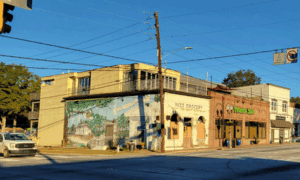A request to rezone 38 acres on Grady Avenue for mixed residential came back to the Fayetteville City Council on Sept. 19 with a revised plan to address density and traffic concerns.
Density had been pared down somewhat and developer Knotty Pine, LLC, said a third lane can be added to Grady Avenue at Ga. Highway 54. But those changes were not sufficient to suit the majority of the 10 area residents who spoke in public comments.
The request asks that the property along Grady Avenue near Hwy. 54 to be rezoned from Medical Office to Planned Community District (PCD).
Density concerns had already surfaced in June when the development was asked to reduce the number of units. Project representative Spurgeon Richardson Thursday night returned with a proposal that decreased the 400 units to 348 units.
When first presented, the proposal included 300 upscale apartments, 67 townhome units and 33 one- and two-story single-family cottages.
“The applicant has responded with a reduction of 52 total units, pulling 24 from the apartments, 38 fewer townhomes and offsetting this number with an increase in 10 single-family detached homes,” said city Community Development Director Brian Wismer. “The revised total distribution of housing is proposed at 276 apartment units, 29 townhomes and 43 detached cottages. This reduces the total density of the development from 10.5 units per acre to 9.2 units per acre.”
Cottages and townhomes are expected to range from 1,500-2,000 square feet and with a price range of $150,000-200,000.
The preliminary plan for apartments would have them range from 700-785 square feet for a one-bedroom with an anticipated average price of $1,047 per month, 1,000-1,175 square feet for a two-bedroom with an average price of $1,393 and 1,400 square feet for a three-bedroom at $1,510.
The council was told the $46 million residential development will be designed to cater to people who work in the Fayetteville area but do not currently live here. That target group also includes young working professionals. Richardson said there is sufficient current demand for upscale housing without taking into account the upcoming opening of Pinewood Atlanta Studios in January.
“Fayetteville currently does not offer any rental options of this quality and proximity to the historic downtown, and this could be an opportunity to keep those employees in the city and not commuting to Atlanta,” said Wismer.
Richardson was insistent that tenants will be screened and that subsidized housing was not a part of the plans for the residential community.
As for the total number of units, Richardson said he would challenge anyone to find a high-end development with fewer than 250 apartments, adding that the density must support the planned amenities. A sampling of those include a fitness center, business center, gazebo, paths and walking trails.
“If we reduce density we will have to lose some of the amenities,” Richardson said.
If approved, the various types of residences will be constructed in a staggered fashion as the need arises.
Pertaining to the other concern from earlier in the summer, the proposal went before the Planning and Zoning Commission on Aug. 27 and received an unfavorable recommendation due largely to unresolved traffic concerns. The applicant since that time has proposed additional solutions that could alleviate those concerns, Wismer said.
Wismer said the traffic study was conducted by Kimley-Horn, which the city has also used for traffic studies in the past. The results of the study recognize that traffic will undoubtedly increase as a result of this development, but that the overall “Level of Service” ranking of Grady Avenue and its ability to accommodate traffic flow will remain the same, Wismer said.
“To minimize this traffic impact, the study also included recommendations for improvements along Grady Avenue and specifically at the Grady Avenue/Hwy. 54 intersection that is of paramount concern,” said Wismer.
Kimley-Horn representative Rob Ross told council members the developer had agreed to widen Grady Avenue as it approaches Hwy. 54. Ross said there is sufficient right-of-way to add a third lane so that the left and center lanes could turn left because the majority of the traffic flows west on Hwy. 54.
“That makes the intersection better than it is today. And they are going to pay for that,” Ross said.
Another option to help mitigate traffic concerns still in the works would involve purchasing a small section of property to the east that would allow the development to link directly to Hwy. 54 nearer to downtown.
Councilman Walt White suggested the development was “still too high on apartments.” White recommended decreasing the density, especially in the number of apartments, and reconfiguring the proposal.
Of the several residents living in proximity to the proposed development, most were in opposition to it. Their two concerns were density and increased traffic.
Many of the neighbors said their concern was not with having townhomes or cottages in the development, and several said they thought those housing options were appropriate. The concern was with the apartments and, specifically, with the 276 currently under proposal.
“If you have apartments you’ll ultimately have crime,” said area neighbor Bob Lester. “It’s a disaster waiting to happen.”
Other residents suggested that apartments would be more appropriate if located along Hwy. 54.
Area resident Shelly Franklin in her comments suggested developing something on the property, but not apartments.
“Apartments will lead to MARTA,” she said. “Three-month people will be transient across the street from a school.”
Asked after the meeting about the the current vacancy rate in Fayetteville’s current apartments, City Manager Joe Morton said the vacancy rate is 4 percent.
The 38-acre property is located adjacent to the Waterfall commercial development.
None of those making public comments mentioned a potential influx into the school system either in the short-term or long-term. A check of the current enrollment at nearby Spring Hill Elementary School showed that, after the recent redistricting, the school current has 155 empty desks.
The current proposal is not the first for the 38-acre parcel. Wismer said the city supported development of the acreage in 2009. An Atlanta Regional Commission land use study at the time showed the benefit of locating a residential community on the property with interconnectivity to the downtown area. With an estimated 300-400 attached units, Stella’s Place did not materialize. The adjacent retail center on Grady Avenue at Hwy. 54 experienced a similar fate for a time. Constructed several years ago, the center sat unoccupied until purchased recently to become the new Waterfall center.
The second reading is expected at the Oct. 3 meeting.
In recommending approval, city planning staff referenced the city’s 2006 comprehensive plan which noted that within the downtown district, development strategies should recognize the need for “a variety of housing options” and “development that will bring residents and (subsequently) neighborhood businesses back to the downtown area. (Achieving) critical density is an essential element of downtown revitalization.”
Along with this, the comp plan also recognizes that “single-family detached housing is not desirable or appropriate for everyone,” said Wismer.
Wismer noted that businesses need people in close proximity to support them, and in order to court further development of our downtown corridor, that downtown critical mass is extremely important when businesses consider where to locate. The forthcoming need for housing that will be generated by Pinewood Atlanta Studios’ activities should also be considered, Wismer said.












Leave a Comment
You must be logged in to post a comment.